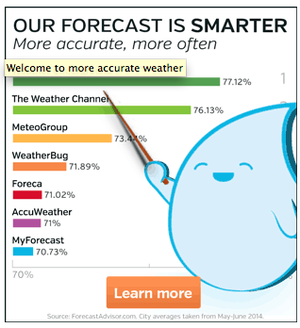Chance News 102
Quotations
Forsooth
Alas, the graph is not smarter:

The nonzero baseline (note the 70% label fading into the background here) is of course a familiar trick for exaggerating comparisons, and examples abound. It just feels worse in a claim about scientific accuracy!
Submitted by Bill Peterson
Ebola quanrantines
How to quarantine against Ebola
by Siddartha Mukherjee, New York Times, 12 October 2014
This op-ed piece dismisses several strategies for containing entry and spread of Ebola in the U.S. in favor of blood-sample screening based on multiplying any genes of the virus present via PCR (polymerase chain reaction).
Author Mukherjee (a professor of medicine at Columbia University) cites a false-positive rate of 3 per thousand and a false-negative rate of 4 per thousand.
Discussion
1. If an average of one person per planeload of 200 people has contracted the Ebola virus, what is the ratio of false positives to true positives in screening such planeloads?
2. If one in 1,000 people screened has the Ebola virus, what is the ratio of false positives to true positives?
3. If one in 10,000 people screened has the Ebola virus, what is the ratio of false positives to true positives?
4. Dr. Mukherjee cites a 2000 study in The Lancet of 24 "asymptomatic" individuals who had been exposed to Ebola. They were tested for the Ebola virus using an earlier version of the proposed screening test. Of the 24:
- 11 developed Ebola, 7 of whom had had positive tests;
- 13 did not develop Ebola, and none of them had tested positive.
From these data, how would you estimate the false-positive rate and false-negative s (with appropriate measures of uncertainty)? (The rates 3/1000 and 4/1000 cited above are for a later version of the method as refined in 2004.)
Submitted by Paul Campbell
Interpreting election forecasts
How not to be fooled by odds
by David Leonhardt, "The Upshot" blog, New York Times, 15 October 2014
Will the midterm elections result in Republican control of the Senate? The latest Upshot forecast gives a 74% chance. Leonhardt observes that the person in the street might interpret this a virtual lock. Nevertheless, he says that people do understand the statement that the chance of rolling a sum of eight or lower with two dice is about 74%: this is a better than even chance, but not a lock. Or, via the complement (26% chance) it is possible to get a sum exceeding eight.
For reference, he gives a list of situations that correspond to the 26% figure. Among these:
- The chances that a blackjack casino dealer busts
- The frequency with which a 25-year-old woman is shorter than 5 feet 3 inches
- The share of Americans who live in California, Texas or New York
Discussion
1. Do you think people confuse a 74% probability with a poll that says 74% of those surveyed say they will vote Republican?
2. (Chance News reader) Emil Friedman commented that parts of the article "may add to students' confusion. Several of his examples merely state the proportion of something in a population. To turn them into probability statements would require changing the wording to read something like 'The probability that a randomly chosen woman will be shorter than 5 feet 3 inches.'"